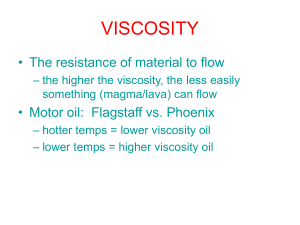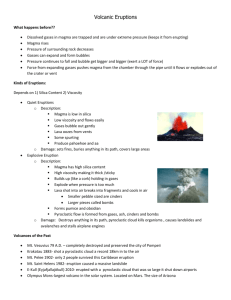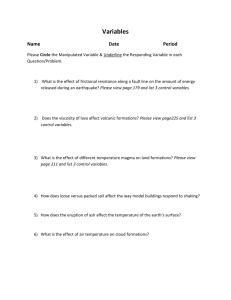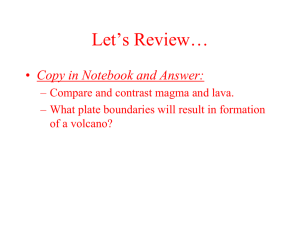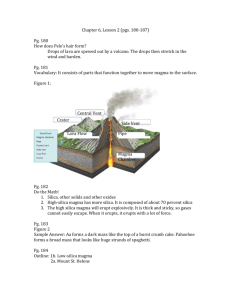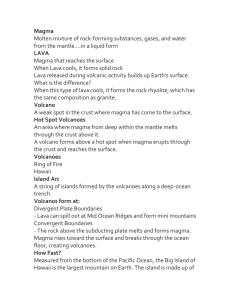Properties of Lava and Magma Notes
advertisement
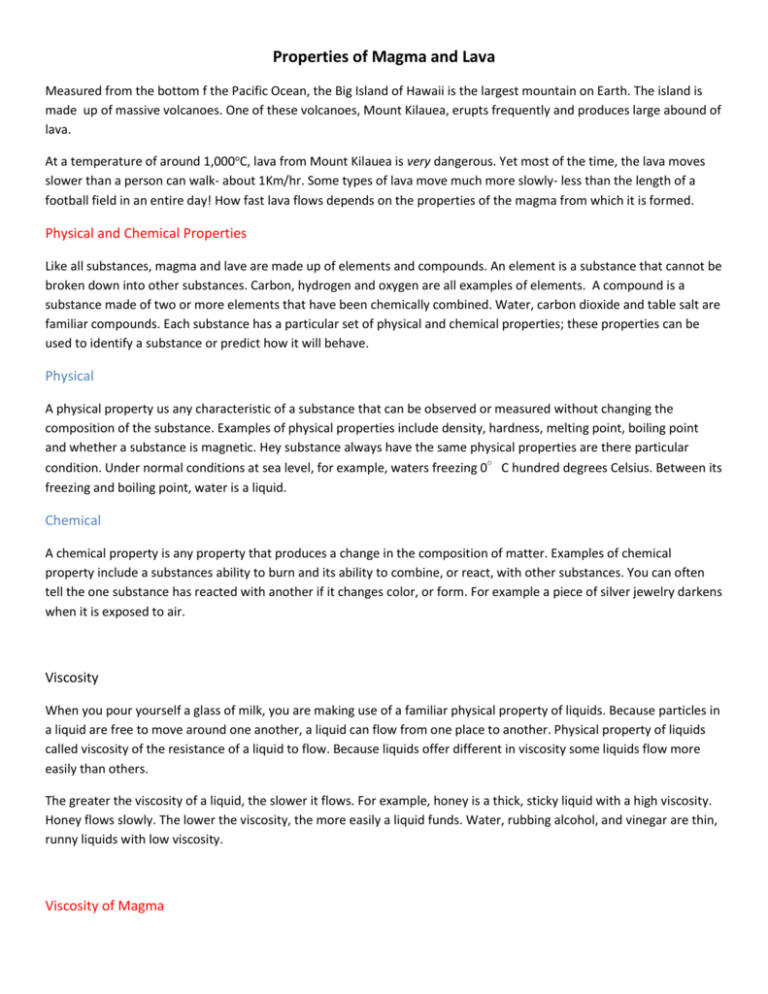
Properties of Magma and Lava Measured from the bottom f the Pacific Ocean, the Big Island of Hawaii is the largest mountain on Earth. The island is made up of massive volcanoes. One of these volcanoes, Mount Kilauea, erupts frequently and produces large abound of lava. At a temperature of around 1,000oC, lava from Mount Kilauea is very dangerous. Yet most of the time, the lava moves slower than a person can walk- about 1Km/hr. Some types of lava move much more slowly- less than the length of a football field in an entire day! How fast lava flows depends on the properties of the magma from which it is formed. Physical and Chemical Properties Like all substances, magma and lave are made up of elements and compounds. An element is a substance that cannot be broken down into other substances. Carbon, hydrogen and oxygen are all examples of elements. A compound is a substance made of two or more elements that have been chemically combined. Water, carbon dioxide and table salt are familiar compounds. Each substance has a particular set of physical and chemical properties; these properties can be used to identify a substance or predict how it will behave. Physical A physical property us any characteristic of a substance that can be observed or measured without changing the composition of the substance. Examples of physical properties include density, hardness, melting point, boiling point and whether a substance is magnetic. Hey substance always have the same physical properties are there particular condition. Under normal conditions at sea level, for example, waters freezing 0°C hundred degrees Celsius. Between its freezing and boiling point, water is a liquid. Chemical A chemical property is any property that produces a change in the composition of matter. Examples of chemical property include a substances ability to burn and its ability to combine, or react, with other substances. You can often tell the one substance has reacted with another if it changes color, or form. For example a piece of silver jewelry darkens when it is exposed to air. Viscosity When you pour yourself a glass of milk, you are making use of a familiar physical property of liquids. Because particles in a liquid are free to move around one another, a liquid can flow from one place to another. Physical property of liquids called viscosity of the resistance of a liquid to flow. Because liquids offer different in viscosity some liquids flow more easily than others. The greater the viscosity of a liquid, the slower it flows. For example, honey is a thick, sticky liquid with a high viscosity. Honey flows slowly. The lower the viscosity, the more easily a liquid funds. Water, rubbing alcohol, and vinegar are thin, runny liquids with low viscosity. Viscosity of Magma At the extremely high temperatures and pressured inside Earth, mantle rock sometimes melts to form magma. Surprisingly, the properties of magma can vary. For example, not all type of magma have the same viscosity. The viscosity of magma depends on its silica content and temperature. Silica Content Magma is a complex mixture, but is major ingredient is silica. The compound silica is made up of particles of the elements oxygen and silicon. Silica is cone of the most abundant materials in Earth’s crust. The silica content of magma ranged from about 50% to 70%. The amount of silica in magma helps determine its viscosity. The more silica magma contains the higher its viscosity. Magma that is high in silica produces light-colored lava that is too sticky to flow very far. When this type of lava cools it forms the rock rhyolite, which has the same composition of granite. The less silica magma contains, the lower its viscosity. Low silica magma flows readily and produces dark-colored lava. When this kind of lava cools, it forms rocks like basalt. Temperature How does temperature affect viscosity? Gather two beakers, dish washing soap, 3 thermometers, 3 pipettes, a hot plate, ice and a lab tray. Place the same amount of dish soap in each beaker. Leave one on the table, place one in the ice and the last beaker on the hot plate. Turn on the hot plate to 3. Place a thermometer in each one. Make your predictions about what will happen to the viscosity of each container of dish soap here: Room Temperature Cooled with Ice Heated Fill each pipette with dish soap (one for room temp, one for cold and one for hot). Turn up your lab tray at an angle.

